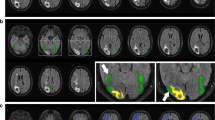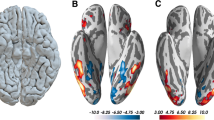Abstract
A patient is presented who developed prosopagnosia with a recent occipitotemporal infarct in the distribution of the right posterior cerebral artery. H ve topographical agnosia or object agnosia. He regained the ability to recognize faces of familiar persons, whereas he remained unable to identify faces of persons whom he met after the of persons whom he met after the disease onset. This case demonstrate that prosopagnosia may occur as a deficit of matching a perceived face to a memory store of the face, and that the failure to recognize unfamiliar faces may be due to the inability to form memory stores of new faces. These deficits can occur in association with a lesion confined to the right occipitotemporal region.
Similar content being viewed by others
References
Arseni C, Botez MI (1958) Consideraciones sobre un caso de agnosia de las fisonomias. Rev Neuropsiquiatr Lima 21:583–593
Assal G (1969) Régression des troubles de la reconnaissance des physionomies et de la mémoire topographique chez un malade opéré d'un hématome intracérébral pariéto-temporal droite Rev Neurol (Paris) 121:184–185
Benson DF, Segarra J, Albert ML (1974) Visual agnosia-prosopagnosia: a clinicopathologic correlation. Arch Neurol 30:307–310
Benton AL (1980) The neuropsychology of facial recognition. Am Psychol 35:176–186
Benton AL, Van Allen MW (1972) Prosopagnosia and facial discrimination. J Neurol Sci 15:167–172
Blanc-Garin J (1984) Perception des visages et reconnaissance de la physionomie dans l'agnosie des visages. Annee Psychol 84:573–598
Bodamer J (1947) Die Prosop-Agnosie (die Agnosie des Physiognomieerkennens). Arch Psychiatr Nervenkr 179:6–53
Bruce V, Young A (1986) Understanding face recognition. Br J Psychol 77:305–327
Bruyer R, Laterre C, Seron X, Feyereisen P, Strypstein E, Pierrard E, Rectem D (1983) A case of prosopagnosia with some preserved covert remembrance of familiar faces. Brain Cogn 2:257–284
Christen L, Landis T, Regard M (1985) Left hemispheric functional compensation in prosopagnosia? A tachistoscopic study with unilaterally lesioned patients. Neurobiol 4:9–14
Cohn R, Neumann MA, Wood DH (1977) Prosopagnosia: a clinicopathological study. Ann Neurol 1: 177–182
Damasio AR, Damasio H, Ban Hoesen GW (1982) Prosopagnosia: anatomic basis and behavioral mechanisms. Neurology 32:331–341
De Renzi E (1986) Prosopagnosia in two patients with CT evidence of damage confined to the right hemisphere. Neuropsychologia 24:385–389
De Renzi E, Scotti G, Spinnler H (1969) Perceptual and associative disorders of visual recognition: relationship to the side of cerebral lesion. Neurology 19:634–642
Ellis HD, Shepherd JW, Davies GM (1979) Identification of familiar and unfamiliar faces from internal and external features: some implications for theories of face recognition. Perception 8:431–439
Gloning I, Gloning K, Jellinger K, Quatember R (1970) A case of “prosopagnosia” with necropsy findings. Neuropsychologia 8:199–204
Habib M, Sirigu A (1987) Pure topographical disorientation: a definition and anatomical basis. Cortex 23:73–85
Hécaen H, Angelergues R (1962) Agnosia for faces. Arch Neurol 7:92–100
Heidenhain A (1927) Beitrag zur Kenntnis der Seelenblindheit. Monatsschr Psychiatr Neurol 66: 61–116
Jeeves MA (1984) The historical roots and recurring issues of neurobiological studies of face perception. Hum Neurobiol 3:191–196
Landis T, Cummings JL, Christen L, Bogen JE, Imhof HG (1986) Are unilateral right posterior cerebral lesions sufficient to cause prosopagnosia? Clinical and radiological finding in six additional patients. Cortex 22:243–252
Landis T, Cummings JL, Benson DF, Palmer EP (1986) Loss of topographic familiarity: an environmental agnosia. Neurol 43:132–136
Landis T, Regard M, Bliestle A, Kleihues P (1988) Prosopagnosia and agnosia for noncanonical views. An autopsied case. Brain 111:1287–1297
Lhermitte F, Pillon B (1975) La prosopagnosie: Rôle de l'hémisphère droit dans la perception visuelle (à propos d'un cas consécutif à une lobectomie occipitale droite). Rev Neurol Paris) 131:791–812
Lhermitte F, Chain F, Escourolle R, Ducarne B, Pillon B (1972) Étude anatomoclinique d'un cas de prosopagnosie. Rev Neurol (Paris) 126:329–346
Malone DR, Morris HH, Kay MC, Levin HS (1982) Prosopagnosia: a double dissociation between the recognition of familiar and unfamiliar faces. J Neurol Neurosurg Psychiatry 45:820–822
Marzi CA, Berlucchi G (1977) Right field superiority for recognition of famous faces in normals. Neuropsychologia 15:751–756
Meadows JC (1974) The anatomical basis of prosopagnosia. J Neurol Neurosurg Psychiatry 37:489–501
Meadows JC (1974) Disturbed perception of colours associated with localized cerebral lesions. Brain 97:615–632
Michel F, Poncet M, Signoret JL (1989) Les lésions responsables de la prosopagnosie sont-elles toujours bilatérales? Rev Neurol (Paris) 146:764–770
Mishkin M (1982) A memory system in the monkey. Philos Trans R Soc Lond [Biol] 298:83–95
Nardelli E, Buonanno F, Coccia G, Fiaschi A, Terzian H, Rizzuto N (1982) Prosopagnosia. report of four cases. Eur Neurol 21:289–297
Pevzner S, Bornstein B, Loewenthal M (1962) Prosopagnosia. J Neurol Neurosurg Psychiatry 25:336–338
Pillon B, Bakchine S, Lhermitte F (1987) Alexia without agraphia in the left-handed patient with a right occipital lesion. Arch Neurol 44:1257–1262
Rondot P, Tzavaras A, Garcin R (1967) Sur un cas de prosopagnosie persistant depuis quinze ans. Rev Neurol (Paris) 117:424–428
Schwartz M, Smith ML (1980) Visual asymmeties with chimeric faces. Neuropsychologia 18:103–106
Shuttleworth EC Jr, Syring V, Allen N (1982) Further observations on the nature of prosopagnosia. Brain Cogn 1:307–322
Sperry RW (1982) Some effects of disconnecting the cerebral hemispheres. Science 217:1223–1226
Squire LR (1987) Memory: neural organization and behavior. In: Mountcastle VB (ed) MD Handbook of physiology, section 1, vol 5, part 1. American Physiological Society, Bethesda, pp 295–371
Torii H, Tamai A (1985) The problem of prosopagnosia: report of three cases with occlusion of the right posterior cerebral artery. J Neurol 232 [Suppl 140]
Tranel D, Damasio AR (1985) Knowledge without awareness: an autonomic index of facial recognition by prosopagnosis. Science 228:1453–1454
Tzavaras A, Merienne L, Masure MC (1973) Prosopagnosie, amnésie et troubles de langage par lésion temporale gauche chez un sujet gaucher. Encéphale 62:383–394
Warrington EK, Taylor AM (1978) Two categorical stages of object recognition. Perception 7:695–705
Whiteley AM, Warrington EK (1977) Prosopagnosia: a clinical, psychological, and anatomical study of three patients. J Neurol Neurosurg Psychiatry 40:395–403
Wilbrand H (1892) Ein Fall von Seelenblindheit und Hemianopsie mit Sectionsbefund. Dtsch Z Nervenheilkd 2:361–387
Young MP, Yamane S (1992) Sparse population coding of faces in the inferotemporal cortex. Science 256:1327–1331
Author information
Authors and Affiliations
Rights and permissions
About this article
Cite this article
Tohgi, H., Watanabe, K., Takahashi, H. et al. Prosopagnosia without topographagnosia and object agnosia associated with a lesion confined to the right occipitotemporal region. J Neurol 241, 470–474 (1994). https://doi.org/10.1007/BF00919707
Received:
Revised:
Accepted:
Issue Date:
DOI: https://doi.org/10.1007/BF00919707




